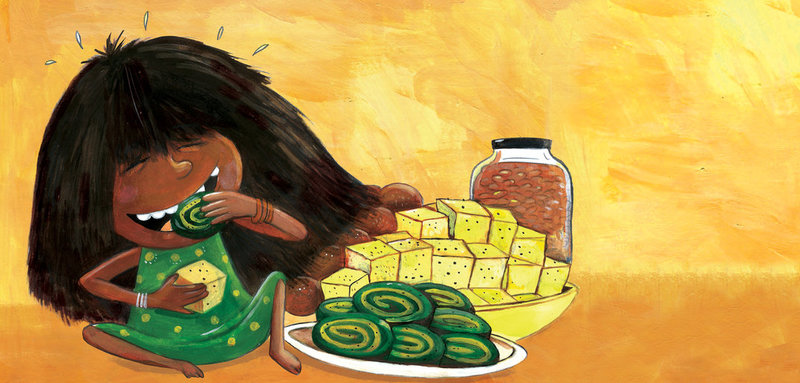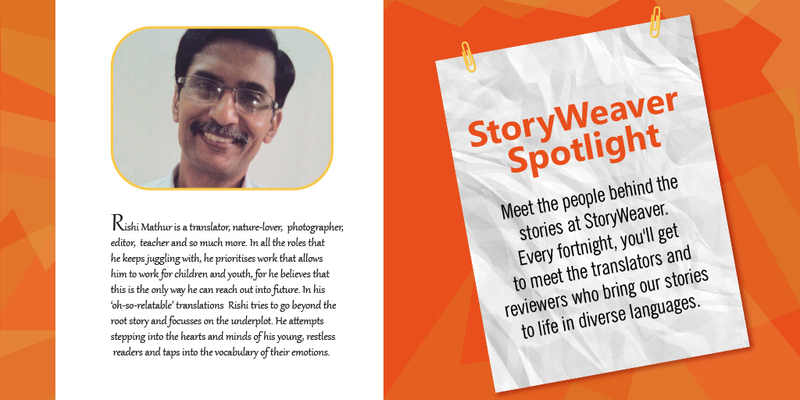Launching StoryWeaver Hindi: A fun, exciting YouTube channel where you can now watch your favourite stories!
Posted by Pallavi Krishnan on January 10, 2019Written by Priyanka Sivaramakrishnan
This World Hindi Day, StoryWeaver is taking yet another step to showcase this beautiful language at a global scale, with the launch of our StoryWeaver Hindi channel on YouTube. Artfully created and carefully subtitled, these YouTube videos will bring the stories to life with their audio-visual engagement, making your kids fall in love with the habit of reading. Following the success of our Readalong feature where children can discover another fun aspect of reading, we are launching this exciting channel where children can watch fun and giggly stories like The Very Wiggly Tooth, What’s Neema Eating Today? Smile Please, and many more.
With new stories every Friday, you can get started on a fun-filled reading experience by subscribing to the StoryWeaver Hindi channel here. This page will soon be joined by a StoryWeaver English channel.
 Image by Priya Kuriyan from 'What is Neema Eating Today?' by Bijal Vachharajani.
Image by Priya Kuriyan from 'What is Neema Eating Today?' by Bijal Vachharajani.
Here at StoryWeaver, we are always looking to see how we can make the reading experience better, what we can give you to help your children revel in the joy of reading. These YouTube videos have been designed with enjoyable background music, a ‘natural’ narrative voiced by professional artists, and synchronized highlighted text running throughout the story. The act of watching the video, listening to the pronunciations, and following the words allows for easy language acquisition by the child.
Aimed at our youngest readers, these stories are mostly Levels 1 and 2 with the videos running no longer than five minutes to make sure we don’t lose the child’s attention. Mirroring the Readalong feature on the StoryWeaver page, the stories have been carefully hand-picked to ensure they include repeat sounds and words, are enjoyable to read aloud, with eye-catching illustrations, and have a fair amount of dramatic flair.
Happy watching!
comment (1)StoryWeaver Spotlight: Rishi Mathur
Posted by Remya Padmadas on January 27, 2017
Q: What do you usually read? Which language do you prefer to read in?
I can read anything that I come across, but content on ‘how things evolve or change’ draws me most, whether it’s covered in philosophy, psychology, spirituality, life sciences, cosmology or for that matter, fiction, which I’m a bit sceptic about, in English.
Q: Is there a favourite book / author and why is it a favourite?
There are many, but a few of them always figure in my all-time favourite list:
'The Prophet' by Khalil Gibran for its profound thought on the basics of life, and simplicity of expression. 'Origin of Species' by Charles Darwin for the way he connected his observations with the realities of the natural world bit by bit to create this ‘enormous whole’ of knowledge. 'A Brief History of Time' by Stephen Hawkings for the way complex phenomena are explained with such clarity therein. 'Conversations with God' sequence of books by Neale Donald Walsch for the style and utility as manuals of spiritual understanding. 'Manwatching' by Desmond Morris, whom I’ve always deemed as my master in absentia, for the rich scientific study in non-verbal communication it is. And all the books by Osho, the great master, whom I could never meet. Though I learned a lot from his mate Dowser S Bhan of Nepal.
Q: You have contributed for us immensely. How has the StoryWeaver journey been?
A: Fantastic! Working for the young readers is always a joy! Wish, it continues as long as I can think and see.
Q: How does it feel when your story gets published online?
A: Nice. But, anticipating another one in my inbox for translation feels a lot better!
Q: You have translated / reviewed a handful of stories for us. Which one has been your favourite and why?
A: Ladle ka Dhol, the very first I translated still tops the list of my favourites. Also developed a special relationship with the Brahmaputra, as I travelled into Tibet through its text!
Q: What is your key driver in taking up these translations?
A: Frankly speaking, being a communicator, I do feel ‘something for all languages,’ but I’m more bent towards the non-verbal aspects, so the key driving force behind translating books or writing something is usually for having the remittances credited into my bank account.
Q: How else do you think we can join hands in taking bigger steps for children’s literature?
A: We can. Through greater and more informal outreach programme. I am really grateful to Pratham Books for giving me an opportunity to interact with young readers in the Pink City during Jaipur Literature Festival. Sharing in person, live interactions by people from the publishing trade can take literature and readership farther than anything else.
Q: How has the overall experience with SW been?
प्रथम बुक्स और स्टोरी वीवर की श्रेष्ठ बाल कथाएं मूलतः चाहे किसी भाषा में लिखी गयी हों, नन्हें पाठकों की दिलचस्पी बनाए रखने के लिए अनुवादक को भाषा की सीमा से पार जाकर, बालमन की कोमल भावनाओं और कथावस्तु से मेल खाती शब्दावली का ध्यान रखना ज़रूरी होता है। ताकि कहानी परायी सी न लगे। यह चुनौती बार-बार सामने आयी। और कामयाबी के साथ इसका सामना किया जिससे ख़ूब ख़ुशी मिली। रचनात्मकता के ऐसे अवसर एक अनुवादक को लेखक के बिकलकुल क़रीब पहुंचने का एहसास कराता है। दूसरों की कलम की जायी कहानी अपनी सी लगने लगती है। ऐसी दत्तक रचनाओं को पोसने का मौक़ा देने के लिए प्रथम बुक्स और स्टोरी वीवर के संपादक मंडल का आभार। इस सुखद स्वाद में जोश का तड़का लगाने का काम किया प्रथम की युवा संपादक आमना सिंह ने। झटपट काम पूरा करने का दबाव बनाने के लिए छुट्टी के दिन भी ख़ुद लगातार संपर्क बनाए रखकर ऐसी चुनौतीपूर्ण समय सीमा में काम करवाया कि हैरान हूं, पर ख़ुश हूं।
The overall experience was good. It was especially nice, because of the great motivation offered by the Pratham Books' team who sounded hard-pressed for deadlines even on Sundays, making me work odd hours at breakneck speeds, making me feel more alive and kicking than I actually am?
Q: You wear many hats - which one is your favourite?
A: I’ve always been a nature lover, and will always be one! But being in the field of communication, I had to yield different tools during different phases of my career, more so for survival than anything else; starting with illustration work for a newspaper, to photography, project documentation for NGOs, new-reporting, editing, television production, research, teaching, translations, and even writing SOPs for students applying for overseas education and finally counselling. Working with children is best, and working for them is next!
Be the first to comment.